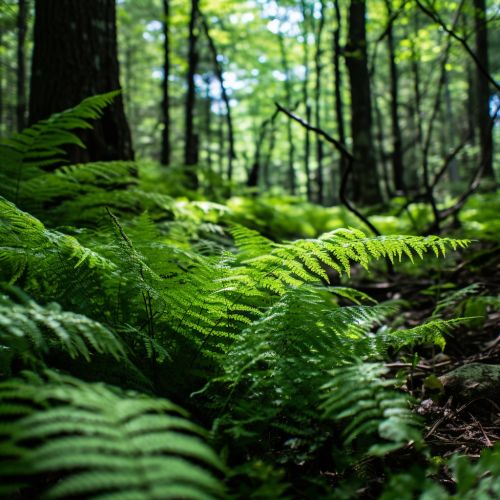Fern
Introduction
Ferns are a group of vascular plants that reproduce via spores, eschewing the seeds and flowers found in most other plant groups. They belong to the division Pteridophyta, which includes over 10,500 species of both aquatic and terrestrial plants. Ferns are found in a wide range of habitats, from remote mountain elevations to dry desert rock faces, to bodies of water or in open fields.


Morphology
Ferns exhibit a great diversity in terms of their physical structure and growth form. They typically possess roots, stems, and complex leaves known as fronds. The fronds are the most visible part of the fern and are often intricately divided.
Roots
The roots of ferns are typically underground and serve to anchor the plant to its substrate. They are also responsible for the uptake of water and nutrients from the soil. These roots are usually fibrous and form a dense network in the soil.
Stems
The stems of ferns can be either creeping or erect. They are often rhizomatous, meaning they grow horizontally under the soil surface. The stem, or rhizome, is usually covered by small, scale-like structures known as rhizoids.
Fronds
The fronds of ferns are the most recognizable feature of these plants. They are typically divided into a stalk, or petiole, and a blade. The blade is often further divided into leaflets, or pinnae, which may be further subdivided into smaller leaflets, or pinnules.
Reproduction
Ferns reproduce via spores, a process that is quite different from the seed-based reproduction seen in many other plant groups. The spores are typically produced on the underside of the fronds, in structures known as sporangia. These sporangia are often grouped into clusters known as sori.
Sporangia
The sporangia are the structures in which the spores are produced. They are typically found on the underside of the fronds, although in some species they may be found on the upper surface or along the margins of the fronds.
Sori
The sori are clusters of sporangia. They vary greatly in shape and arrangement, and their characteristics are often used in the identification of fern species.
Ecology
Ferns are found in a wide range of habitats and are often key components of their ecosystems. They play important roles in nutrient cycling, soil stabilization, and providing habitat for other organisms.
Habitats
Ferns are found in a wide variety of habitats, from wetlands to dry deserts, and from sea level to high mountain elevations. They are particularly abundant in tropical rainforests, where they may form a dense understory.
Interactions with other organisms
Ferns interact with a wide range of other organisms in their ecosystems. They provide habitat for many species of insects and other invertebrates. Some species of birds also use ferns for nesting or foraging.
Classification
The classification of ferns has been a subject of much debate among botanists. They are currently classified in the division Pteridophyta, which is divided into several classes and orders.
Cultural significance
Ferns have been used by humans for thousands of years for a variety of purposes. They have been used as food, medicine, and in the production of craft items such as baskets and mats.
